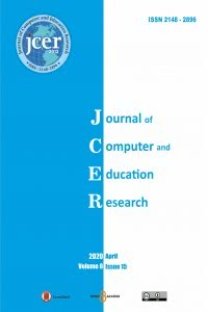Ters Yüz Sınıf Modeline Yönelik Dijital İçerik Tasarımı: Biyoloji Dersi Örneği
Biyoloji, dijital içerik, h5p, tasarım, ters yüz sınıf modeli
Digital Content Design for the Flipped Classroom Model: Example of Biology Lesson
Biology, design, digital content, flipped classroom model, h5p,
___
- Abeysekera, L., & Dawson, P. (2015). Motivation and cognitive load in the flipped classroom: definition, rationale and a call for research. Higher Education Research & Development, 34(1), 1–14. https://doi.org/10.1080/07294360.2014.934336
- Alruwaili, T. (2016, June). Investigating student motivation and expectation on attitude toward flipped learning. Proceedings of the 1st Annual Higher Education Flipped Learning Conference, Greeley, Colorado.
- Altemueller, L., & Lindquist, C. (2017). Flipped classroom instruction for inclusive learning. British Journal of Special Education, 44(3), 341–358.
- Baker, J. W. (2016, June). The origins of “the classroom flip.” Proceedings of the 1st Annual Higher Education Flipped Learning Conference, Greeley, Colorado.
- Bergmann, J., Overmyer, J., & Wilie, J. (2012). The flipped classroom: Myths vs reality. The Daily Riff: Be Smarter about Education.
- Bergmann, J., & Sams, A. (2012). Flip your classroom: Reach every student in every class every day (1st ed.). Eugene, Oregon: ISTE: International society for technology in education.
- Bishop, J., & Verleger, M. A. (2013, June). The flipped classroom: A survey of the research. 2013 ASEE Annual Conference & Exposition, 23–1200.
- Davies, R. S., Dean, D. L., & Ball, N. (2013). Flipping the classroom and instructional technology integration in a college-level information systems spreadsheet course. Educational Technology Research and Development, 61(4), 563–580.
- Fernández-Martín, F.-D., Romero-Rodríguez, J.-M., Gómez-García, G., & Ramos Navas-Parejo, M. (2020). Impact of the flipped classroom method in the mathematical area: A systematic review. Mathematics, 8(12), 2162.
- Flipped Learning Network (FLN). (2014). The four pillars of FLIP.
- Fulton, K. P. (2012). 10 reasons to flip. Phi Delta Kappan, 94(2), 20–24.
- Gücükoğlu, B., Ceylan, D. Y., & Dursun, Z. (2013, December). Etkileşimli tahta için arayüz tasarımı ve içerik geliştirme: Coğrafya dersi örneği. XVIII. Türkiye’de İnternet Konferansı.
- Hartini, S., & Mahtari, S. (2018). Developing of physics learning material based on scientific literacy to train scientific process skills. Journal of Physics: Conference Series, 1097(1), 012032.
- İşçi, T.G. & Yazıcı, K. (2023). The effect of the use of the flipped learning model in the social studies course on the students’ academic success and higher-order thinking skills. International e-Journal of Educational Studies, 7 (13), 46-64. https://doi.org/10.31458/iejes.1216865
- Johnson, D. (2012). Power up!: Taking charge of online learning. Educational Leadership, 70(3), 84–85.
- Kırmızıoğlu, H. A., & Adıgüzel, T. (2019). Ters yüz sınıf modelinin lise seviyesinde uygulanması: Kimya dersi örneği. D.Akgündüz (Ed.), Fen ve matematik eğitiminde teknolojik yaklaşımlar içinde (92–114). Ankara: Anı Yayıncılık.
- Koçdar, S., Karadeniz, A., Bozkurt, A., & Büyük, K. (2017). Açık ve uzaktan öğrenmede sorularla zenginleştirilmiş etkileşimli video kullanımı. Eskişehir Osmangazi Üniversitesi Sosyal Bilimler Dergisi, 18(2), 93–113. Lumi. (2022). Main page. https://app.lumi.education/.
- Lynn, M. R. (1986). Determination and quantification of content validity. Nursing Research, 35(6), 382–386.
- Milli Eğitim Bakanlığı Talim ve Terbiye Kurulu Başkanlığı [MEB-TTKB]. (2022). Elektronik eğitim içerikleri: Genel bakış. Ankara: Elektronik Eğitim İçerikleri Daire Başkanlığı.
- Moore, M. G. (1989). Editorial: Three types of interaction. American Journal of Distance Education, 3(2), 1–7. https://doi.org/10.1080/08923648909526659
- Papsch, F. (2022). Interactive H5P-Inhalte mit Lumi. Digital Unterrichten: Biologie, 2022(6), 12.
- Polit, D. F., Beck, C. T., & Owen, S. v. (2007). Is the CVI an acceptable indicator of content validity? Appraisal and recommendations. Research in Nursing & Health, 30(4), 459–467.
- Richey, R. C., & Klein, J. D. (2005). Developmental research methods: Creating knowledge from instructional design and development practice. Journal of Computing in Higher Education, 16(2), 23.
- Şimşek, N. (2015). Çağdaş eğitim sorunları karşısında yeni bir eğitim ortamı etkileşimli video. Ankara University Journal of Faculty of Educational Sciences (JFES), 27(1), 195–210.
- Singleton, R., & Charlton, A. (2020). Creating H5P content for active learning. Pacific Journal of Technology Enhanced Learning, 2(1), 13–14.
- Uğur, S., & Okur, M. R. (2016). Açık ve uzaktan öğrenmede etkileşimli video kullanımı. Açıköğretim Uygulamaları ve Araştırmaları Dergisi, 2(4), 104–126.
- Wilson, A. D. (2016). The flipped approach: The use of embedded questions in math videos [Unpublished master's thesis]. The University of Texas at El Paso.
- Yayın Aralığı: 2
- Başlangıç: 2013
- Yayıncı: Tamer KUTLUCA
Trends of Graduate Theses on Media Literacy: A Content Analysis
Mathematical Modelling: A Retrospective Overview
Ters Yüz Sınıf Modeline Yönelik Dijital İçerik Tasarımı: Biyoloji Dersi Örneği
Hüseyin Cihan BOZDAĞ, İsa GÖKLER
Öznur KARASUBAŞI, Hatice GÜNGÖR SEYHAN
The Impact of Secondary School Students’ Hygiene Habits on Environmental Knowledge
Sedenay DEMİR, Mehmet Akif HAŞILOĞLU
Yasemin SERBEST, Mehmet Kemal AYDIN, Metin KUŞ
Dördüncü Sanayi Devrimi Karşısında Akademisyenler ve Öğrenciler
Ortaokul 8. Sınıf Öğrencilerinin Matematiksel Söylemlerinin İncelenmesi: Doğrusal Denklemler Durumu
